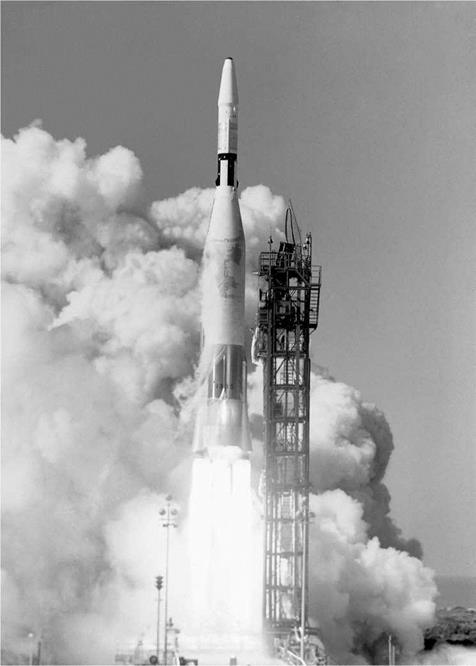LOBOTOMY
Ranger 4 arrived at the Cape on 26 February 1962. The countdown ran smoothly to liftoff at 20:50 GMT on 23 April. The Atlas performed satisfactorily, the Agena achieved the desired parking orbit and then made the translunar injection manoeuvre as planned. But when the spacecraft appeared above the horizon at Johannesburg it was transmitting a carrier signal without encoded telemetry, which meant that it was not possible to determine the state of the systems. Unable to lock onto the Sun, the initial instabilities imparted by separation from the spent stage caused the spacecraft to tumble. It was concluded that the master clock in the computer/sequencer must have failed. Ranger 4 had transmitted telemetry during the ascent, but the clock had stopped at some point in the gap in coverage between the vehicle passing beyond the final station of the Eastern Test Range and its coming into range of Johannesburg. In effect, the Agena had released a lobotomised robot. Ironically, the radar tracking by Woomera showed that the slight discrepancy in the trajectory would have been well within the capacity of the spacecraft to correct.
The target for Ranger 4 was the same as for its predecessor. The Moon was ‘full’ on 20 April and would be ‘last quarter’ on 27 April. James Webb, W. H. Pickering, Oran Nicks, Clifford Cummings and James Burke congregated at Goldstone on 26 April as the spacecraft approached the Moon. Without solar power, the battery had expired, terminating the carrier wave from the main transmitter, but the fact that the independently powered surface package was transmitting enabled radio tracking to continue. At 12:47 GMT, some 64 hours after launch, the spacecraft passed behind the leading limb of the Moon. Calculations showed that it impacted 2 minutes later.
For the first time, American hardware had hit the Moon, marking a success for
|
On 23 April 1962 an Atlas-Agena lifts off with the Ranger 4 spacecraft. |
the launch vehicle – but this was little consolation for the spacecraft engineers, and the scientists gained nothing. On the one hand, in the original concept of the Block II it was deemed that three flights would be necessary to have a reasonable probability of achieving a fully successful flight that would deliver the scientific objectives of the project. However, the scientists appeared to think that every flight should succeed! It was difficult to precisely determine why Ranger 4’s clock had stopped, because the failure occurred when out of communication and it prevented the transmission of telemetry. But because the telemetry was present when the spacecraft was last seen on the Agena and absent following its release, attention focused on the separation procedure – in particular, when the umbilical plug was withdrawn from the bus and the onboard computer/sequencer issued the power-up command to the systems. It was inferred that there must have been a short circuit at this time, and the obvious root cause was the heat sterilisation process. Additional waivers were issued, but the computer/sequencer for Ranger 5 had already been treated. With mass no longer an issue for the Block II, it was decided to install a backup clock in order to ensure that telemetry would be produced in the event of the computer/sequencer being disabled.











